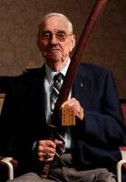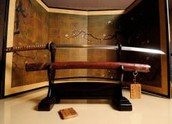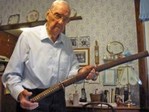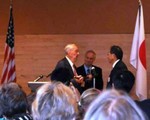Return of the Sword - American Legion Post #40
Main menu:
Return of the Sword
Special Interests
ONE MAN'S SOUVENIR, ANOTHER MAN'S HEIRLOOM
Orval and Marie Amdahl of Lanesboro, MN enjoy watching PBS's Antiques Roadshow. The stories of forgotten heirlooms and priceless treasures discovered in attics and closets intrigue the Lanesboro couple just like those people on the show. The Amdahls haven't been on the show, but they did have a treasure of their own that is just as unique and even more meaningful on an international level.Orval had a sword sitting in his closet for 68 years. Every time he took it out to oil, hewould see its leather-covered wooden scabbard. He would wrap both hands around the two-handed leather grip and feel the weight of 26 inches of steel. When sheathed, the three-foot sword would look like a cylinder with only a slight taper near the point. When drawn, the blade's singular edge would warn anyone near it to be careful. As Orval Amdahl had been oiling the samurai sword over the past 68 years, he probably never realized he’d be caring for his World War II souvenir in preparation to present it to another man as a cherished family heirloom.How Orval got there . . .Orval enlisted in the Marine Corps and was sworn in on May 5, 1941, and graduated from St. Olaf College on June 4, 1941. Prior to being called for officer training, Orval taught math in Lanesboro.On Dec. 7, 1941, the day Pearl Harbor was attacked by the Japanese, Orval told the school district they would need to find a replacement for him. He left for training in Quantico, Va., in April of 1942. While in Virginia, Orval underwent a time of both physically and mentally grueling preparation. "If you didn't cut the mustard, you got out," he stated. He received his commission on June 14, 1942, and went into Reserve Officer Training for special weapons and heavy artillery until October.Having a choice where to serve, Orval decided to head into the Pacific. "I felt I was called to serve my country," he expressed. "Personally, I wanted to retaliate." He left for the Hawaiian Islands on Nov. 19, 1942, and became part of the First Marine Amphibious Corps in the 20mm anti-aircraft gun battery. Island-hopping, the corps made its way to Tulagi and then the Russell Islands, where they protected airstrips and harbors from Japanese who flew over the island to get to Guadacanal.Orval said the corps was supposed to get some rest and recuperation in New Zealand, but was called into action at Enewetak in the Marshall Islands. There, Orval took over as captain of the 90mm gun battery. After 25 months of moving around the Pacific, Orval was able to be home in time for Christmas in 1944.He had married Marie in 1942 after he received his commission and was happy to finally be home. "I figured I wouldn't get sent overseas again," he stated. However, he got called back into field artillery training in Quantico and took over a battery in Saipan in June of 1945. During that time, military forces were preparing to invade Japan.Orval's group was aboard a ship heading toward Japan when they heard about atomic bombs being dropped on Hiroshima and Nagasaki. "We knew there was something big, but didn't know the truth about the bombs," he said.Postponing entry, the group finally arrived in Nagasaki in October of 1945. "The devastation was unreal and I hope I never see it again," Orval recalled. While there, they faced no direct opposition by Japanese forces or the Kamikaze suicide-bombers. At that point, Orval said the U.S. military was working with the Japanese. "Their way of life was different, but they were human beings," Orval added.The story behind the samurai sword . . .On August 9, 1945, an atomic bomb given the name of “Fat Man” was dropped over the Japanese city of Nagasaki. This was the second atomic bomb dropped on a major city in Japan in less than four days, as a measure of response to the Japanese attack on America at Pearl Harbor on December 7, 1941.Sixty-eight years later, there are many people today who remember what life was like back then, contending with the tension that created a dividing line between Americans and Japanese as two worlds collided on a global scale.Orval Amdahl, a 94-year-old Lanesboro native and resident, remembers that day very well. He was on a ship out at sea waiting for clearance to hit the beaches of Nagasaki. Once the atomic bomb had been dropped on Nagasaki, “we were at sea until the geiger counters had cleared the area from fallout,” recalled Amdahl.And then “the treaty had been signed in Tokyo before we got off the ship,” he said. As a member of the Third Battalion, Tenth Marines, Second Marine Division, Fleet Marine Force, Captain Orval Amdahl hit the beaches of Nagasaki on an LST (Landing Ship, Tank) with the rest of his unit.The soldiers were told to leave their guns on the ship, since they did not want to pose a threat to the already shaken survivors of the atomic bomb. They wanted to merely occupy the area of Nagasaki.Amdahl recalls walking the streets of Nagasaki and seeing eight story buildings turned to rubble and ash. In the beginning, only the Japanese men came out of what remained for housing at that time. The men kept their women and children hidden from the American soldiers, fearing what they might do to the Japanese. But, as there became a better understanding that the Americans were merely occupying the region, the residents of Nagasaki started to gain a sense of trust.While in Nagasaki, Captain Amdahl was granted permission by his Lieutenant Colonel to enter any“Off-Limits” area and pass on and off the base at any time. While inspecting a Japanese navalshipping warehouse, Amdahl and his fellow soldiers found a huge pile of samurai swords. All of the soldiers grabbed a sword, resting safely in a scabbard. It wasn’t considered looting as the soldiers were allowed to go in and take a souvenir. Most of the soldiers got their hands on a shiny metal scabbard and sword, but Amdahl climbed to the top of the pile and grabbed one samurai sword housed in a leather scabbard. And, with permission from the military, Amdahl was allowed to bring the samurai sword back to the United States as a “war trophy.Fast forward to today, 68 years later, you find a remarkable story that encourages peace and closure.From Lanesboro to Nagasaki . . .The connection between Orval Amdahl and Tadahiro Motomura, two men whom had never met, came about when author Caren Stelson was researching World War II veterans who served in Nagasaki during the period of time in which Amdahl was stationed there.Stelson found Orval Amdahl’s information at the Minnesota Historical Society, and she reached out to him to schedule an interview. During the interview, he showed her his samurai sword and scabbard. Included with the scabbard was a flat piece of wood with Japanese writing that provided enough information to start connecting the dots.Amdahl took the sword to an expert sword appraiser in the Twin Cities, and he found a wooden peg on the handle of the sword that told him who made the sword and when the sword was made. This samurai sword was made in 1941 and was handcrafted by the one of the best sword makers in Japan specifically for Tadahiro Motomura’s father, an officer in the Japanese military.From there, Caren Stelson used her connections in Nagasaki to locate the family. Specifically, Stelson was well connected with a Nagasaki woman who was 12-years-old when the bomb was dropped on her hometown in 1945. Caren and her connections led to the discovery of the Motomura family.In addition, Amdahl has received a flood of calls for interviews from local, regional and state-wide media. And, along the way, he has met a lot of interesting people such as the grandson of our 33rd U.S. President Harry S. Truman. Clifton T. Daniel, residing in Chicago, came to visit Amdahl at his home in Lanesboro, because he is working on a book relating to how people who were alive during World War II view each other today from America to Hiroshima to Nagasaki. Interestingly, President Harry S. Truman was in office when the decision was made to drop bombs on Hiroshima and Nagasaki in 1945.While Amdahl is a modest small town man, his story attracted attention on an international scale. And, there are so many reasons this connection and this sword have become a big deal.St. Paul and Nagasaki have been sister cities since establishing the official Saint Paul - Nagasaki Sister City Committee in 1955. And, Tadahiro Motomura, Journal Nagasaki Executive Director, has been an advocate of the Nagasaki Atomic Bomb Museum and their efforts to promote a peace exhibition titled “From a Culture of Violence to a Culture of Peace: Transforming the Human Spirit” -- hosted in 50 cities in 22 countries around the world.Back in 1960, someone offered Orval Amdahl $60 for the prized samurai sword, and he turned that offer down. Then in the mid-1990s, he was offered $2,500 by another individual, and he turned that offer down, as well. Amdahl could have sold the sword and made good money, but he chose to hang on to the sword. And, it’s a good thing he did.As Amdahl said during his interview, “I’m a believer in peace, and wanted to strengthen our relationship with Japan; returning this sword to its rightful owner.”As America and Japan continue to seek understanding and closure to a defining moment in the history books, Amdahl and Motomura attempt to nurture that relationship in the direction of peace and friendship when the 1941 samurai sword changed hands on Saturday, September 21, 2013.Returning of the Sword . . .On Saturday, September 21, 2013, at the Como Park Zoo and Conservatory Visitor Center in St. Paul in an event appropriately named “Return of the Sword Ceremony,” Orval Amdahl presented the samurai sword to Mr. Tadahiro Motomura of Nagasaki, the son of the original owner of the samurai sword. As the oldest living male descendant of the Motomura family, Tadahiro was slated to be the keeper of the sword.The ceremony took place in Como Park near the Charlotte Partridge Ordway Japanese Garden, which was designed by Nagasaki-native Masami Matsuda. Also nearby is a cherry tree grove started in 2012 as a 100-year-anniversary of the cherry tree gift to Washington, D.C. The perfect venue.The event began on Saturday morning at 9 a.m. and was emceed by Clifton Truman Daniel, a grandson of United States President Harry S. Truman. Daniel had been in contact with Orval about a book he was writing on the Hiroshima and Nagasaki bombings, which were ordered by his grandfather.St. Paul Mayor Chris Coleman greeted the crowd and the Japanese Consulate also shared words.Orval and Motomura then exchange words via interpreters. After the sword was returned to Motomura and his family, Minnesota Secretary of State Mark Richie shared words during a private lunch for the families.Japanese sword expert Bill Rannow, who also worked on cleaning the sword, said returning weapons to Japan is very uncommon. "Most families don't want anything to do with the war". However, the sword makes a great story Motomura will be able to share with the local newspapers in Japan. That may be easy since he is the president of the Nagasaki Shimbun newspaper.The returning of the sword had gotten to be outside the realm of returning a sword. It had gotten to be international. The Japanese government normally does not allow weapons to pass through customs into the country. Motomura had been working to get the sword certified so he can actually take it home. If there were any issues with taking the sword back, former U.S. Vice President and United States Ambassador to Japan, Walter Mondale expressed his willingness to negotiate the sword's repatriation. However expectations were that there would be no problems with Motomura returning with the sword as it had already become a symbol of peace between two nations and two peoples.Upon returning . . .Despite living on a rural driveway high above a small Minnesota town, Orval has attracted the attention of several news media outlets and expects there will be more of the same following the ceremony.Quietly, he and Marie will return home without the sword, which will be on its way to Japan for good. No longer will he need to oil the razor-sharp blade."I think this is a form of closure," he reflected. A connecting piece to his days in the Pacific will be gone, yetin its place will be left an even stronger connection: a more human one. "It's going back to the rightful owner."The story of the sword could not have started without a man receiving it while serving his country. It could not have been continued without Orval taking it home across the ocean. It could not have been rediscovered without Caren's summer visit. It could not have had its richness added without a deep sister-city connection. It will not be able to continue without its return to Japan and its family.The story of the sword continues and throughout the future generations, a family will sit down and start telling it, from the beginning.
Have questions or comments? We welcome your opinion. Please email your comments or suggestions to webmaster@lanesboroamericanlegion.org or call Anne at 507-460-9040. Thank you for your support.






